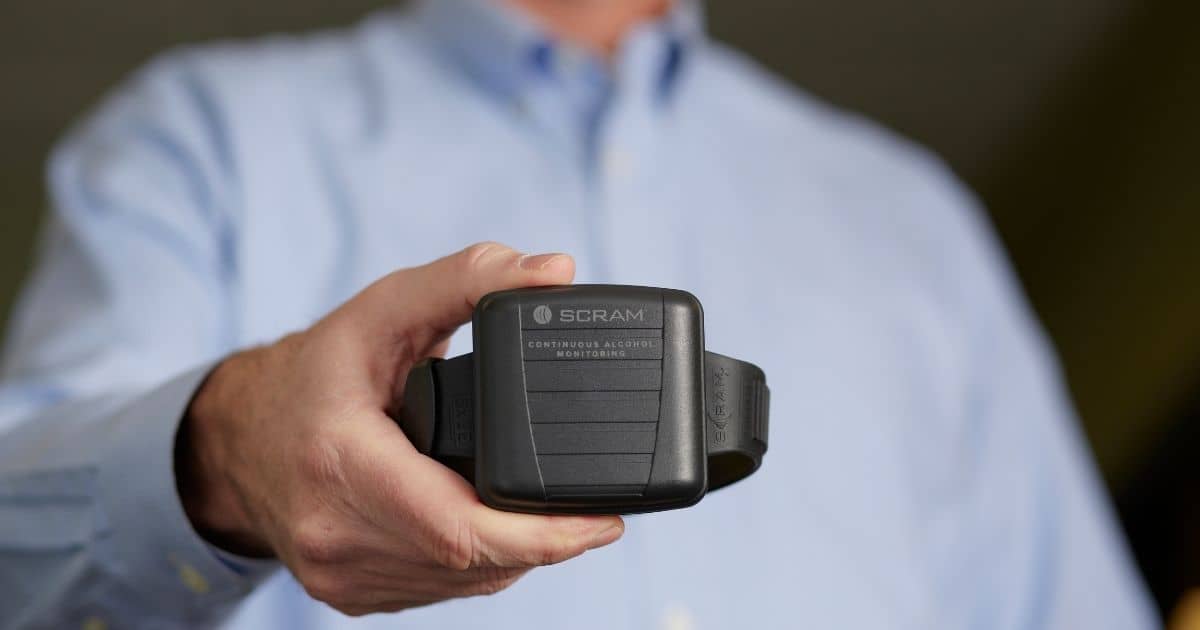Recently, the use of “sobriety tags”—or SCRAM Continuous Alcohol Monitoring® (SCRAM CAM®) devices—have launched across England and Wales to monitor individuals convicted of alcohol-related crimes. These individuals can be ordered to an Alcohol Abstinence Monitoring Requirement (AAMR), which is a new sentencing power that requires the offender to wear a SCRAM CAM tag, and can be imposed as both a punitive and rehabilitative requirement. The tag can not only detect if the wearer has breached the alcohol ban by consuming alcohol, but also assist in improving their lifestyle and helping them avoid crime.
The SCRAM CAM tag is a device worn on the ankle that takes a sample of the wearer’s sweat and conducts a test every 30 minutes, alerting supervising authorities if alcohol is detected. The SCRAM CAM system is able to differentiate consumed alcohol from “environmental alcohol” such as perfumes, hand sanitizers, and more, providing a reliable method to monitor individuals for alcohol use 24/7. In addition, various pilot programmes were implemented across London, Humberside, Lincolnshire, and North Yorkshire between 2014 and 2019 and yielded client compliance rates of more than 97%.
The efficacy of this technology does not end with these cases alone. The implementation of sobriety tags in pretrial, bail, and prison licence scenarios is a logical next step, further helping individuals abstain from circumstances that result in entanglements with alcohol-related crimes.
Benefits of Sobriety Tags in Pretrial, Bail, and Licence Settings
The Office for National Statistics has stated that 40% of all violent crime and 28% of all domestic violence incidents are carried out by offenders believed to be under the influence of alcohol. In addition, the Government has noted that alcohol-related crime costs the economy £21.5 billion a year.
But community supervision programmes—such as pretrial and licence settings—that leverage technology like the SCRAM CAM sobriety tag, can enable courts and agencies to monitor individuals in the community while reducing the costly burden placed upon prisons.
By monitoring clients on licence or bail, they can remain active members of their community and contribute to their own rehabilitative success. Instead of sending such suspects or offenders straight to prison, bail and licence programmes allow individuals to participate in treatment while remaining employed and involved in their communities. In pretrial programmes, individuals may be fitted with a tag prior to being convicted of a crime, so that they may demonstrate their sobriety to the court. The use of sobriety tags in these situations may also help these individuals avoid reoffending in the future.
“These tags have already brought enormous benefit to Wales since they were introduced in October, with one offender I met saying it not only changed his ways, but also saved his life.”
Kit Malthouse MP, Crime and Policing Minister
Sobriety Tag Success
The SCRAM CAM tag is commonly used in pretrial and bail programs across the United States, and since 2004, over 815,000 individuals have been monitored with the tag. Of those individuals, there is an average daily compliance rate, or Sober Days rate, of 99.3%.
Two projects in the UK, which started in 2019, have also experienced success from using the tag. Seeking to address alcohol-related crimes for both high- and medium-risk offenders, the Durham Police and Crime Commissioner offer the SCRAM CAM tag to offenders as part of their offender management or deferred prosecution scheme. The key aim of this project is to use alcohol monitoring and sobriety as a means to deter alcohol-related crimes.
The Nottinghamshire Police and Crime Commissioner use the tag to monitor offenders already engaged with the police to help manage their alcohol use. Participation in this program may open up access to additional support for offenders, and the tag offers a more evidence-based view of the offender’s drinking behaviour.
“Nottinghamshire use the tags very much as a tool for rehabilitation, and the positive behavioural reform seen has been attributable to a collaboration between the innovative technology and enhanced information which the tag offers, and effective professional engagement.”
Paul Harris, Nottinghamshire Police
Expanding the Benefits of Sobriety Tags
While the success of the use of SCRAM CAM sobriety tags in accordance with the AAMR continues to grow, parties such as police and crime commissioners and Her Majesty’s Prison and Probation Service could consider additional uses for such technology. This may include fitting individuals arrested for alcohol-involved crimes prior to conviction, such as in pretrial programmes, and in bail and licence situations to help offenders of such crimes successfully re-integrate into their communities and support rehabilitation efforts to improve their lives.
Successful reentry planning combined with technology-driven programmes and services, like the use of the SCRAM CAM sobriety tag, can positively impact outcomes for justice-involved populations.

